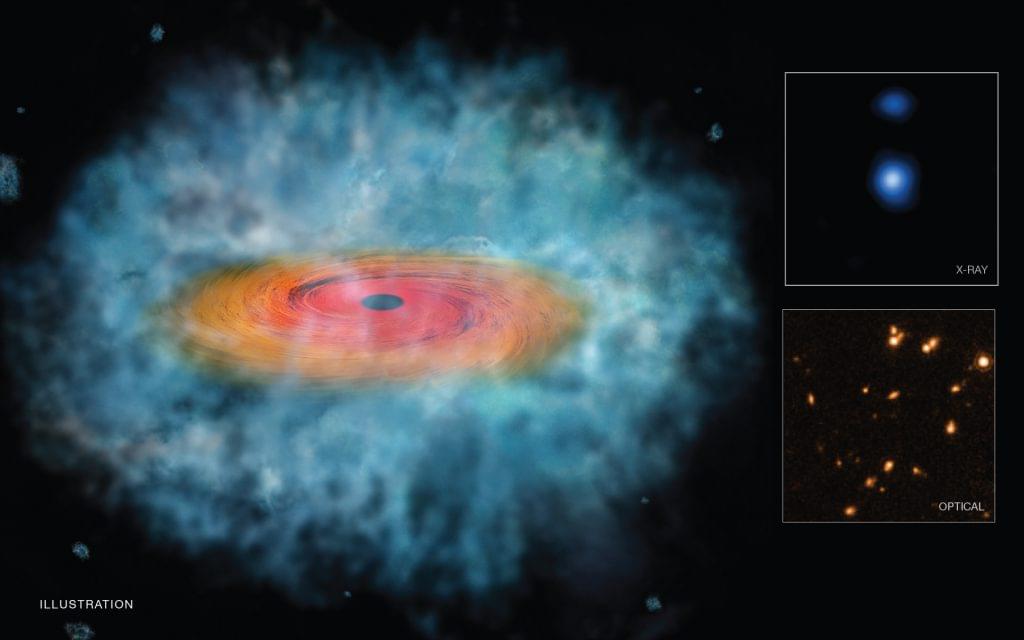At the center of almost every galaxy around us, we found super-massive black holes with a mass of million or billion times that of the Sun. In our galaxy, the Milky Way, there is a black hole with about 4 million solar masses. Some of these black holes are active and devour huge amounts of gas, irradiating their own host galaxy. Others, like the Milky Way one, are more quiet.
Current theories successfully describe the formation process of small black holes, up to tens of solar masses. These objects are formed with the collapse of stars more massive than the Sun, at the end of their life. From small black holes, of “stellar mass”, it is possible to form super-massive black holes through a growth process, accreting gas from the surrounding environment or merging with other black holes. Nonetheless, this process requires a long time, billion years, to finally reach the size of super-massive black holes.
As usual, nature has some surprises for us: these super-massive black holes not only are commonly observed at the center of close-by galaxies, but they have been localized also in extremely far away galaxies, very old ones, existed when the Universe was 800 million years old. A small fraction when compared to the 13-14 billion years of its current age. Understanding how it was possible to form black holes of billion solar masses in such a short time is one of the biggest mystery in modern cosmology.
One of the theories proposed to solve this puzzle states that, in the peculiar conditions of the early Universe, black holes formed in the first billion years form the Big Bang were much more massive than the ones formed at the end of the life of a modern star. Not tens, but up to 100,000 times the mass of the Sun. These objects are named direct collapse black holes. As the name suggests, they should have been formed from the direct collapse, without fragmentation, of huge amounts of primordial gas. Instead of forming 100,000 stars similar to the Sun, they formed just a single, collapsed, object of 100,000 solar masses. The existence of these intermediate-mass objects would help in the understanding of the observations indicating the presence of super-massive black holes in the early Universe. They would then represent the missing link between small black holes, formed from stars, and super-giant ones, found at the center of galaxies. Direct collapse black holes are objects imagined by astrophysicists, but never observed before.

In a very recent study led by Fabio Pacucci and Andrea Ferrara, cosmologists at the Scuola Normale Superiore, the authors believe that they have found a simple and effective method to observe the first black holes formed in the Universe. This study suggests that it is possible to select these objects, among the billions populating the sky, looking at their colors. Observed through special photometric filters (that allow to select some wavelengths, similarly to photographic filters), these objects should appear much redder than other objects observable in the early Universe. Fabio Pacucci, first author of the study, says: “This reddening should be caused by the huge amount of gas present in the host galaxy, and collapsing toward the central object. The light emitted from the environment surrounding the central black hole would lose energy crossing it and would become redder, less energetic.” We predict that the reddening should decrease with time, because the gas present in the host galaxy decreases as well. Similarly to the daily cycle of the Sun, at the rise of their life these black holes are very red, progressively turning whiter with the approaching of noon.
This method was applied from the authors of the study. They found two very ancient objects that could be the first black holes of this class ever discovered. These objects were observed in the visible light and in the infrared from the NASA space telescopes Hubble and Spitzer, inside the southerner constellation of the Fornax. Furthermore, these objects are clearly detected in the X-rays from the NASA space telescope Chandra. The emission of high-energy radiation, like the X-rays, strongly suggests that these objects are really black holes. These two objects were formed when the Universe was younger than one billion years, less than one tenth of the current age.
Andrea Ferrara, Cosmology professor at the Scuola Normale Superiore, says: “If this discovery will be confirmed, out vision of the formation mechanisms of super-massive black holes would dramatically change”. Direct collapse black holes would represent the progenitors of local super-massive black holes, localized at the center of most galaxies. Consequently, also our understanding of the formation process of galaxies would be improved.
